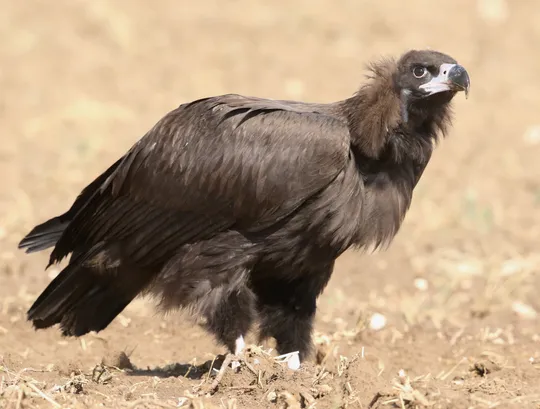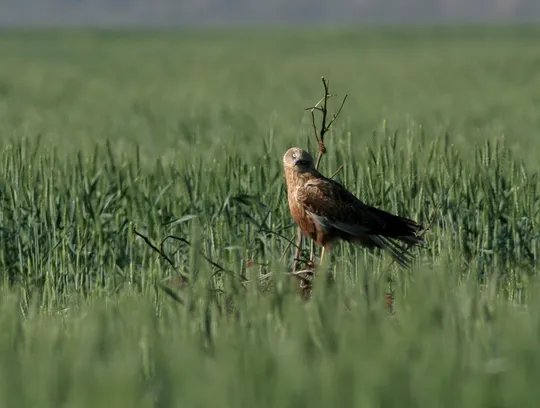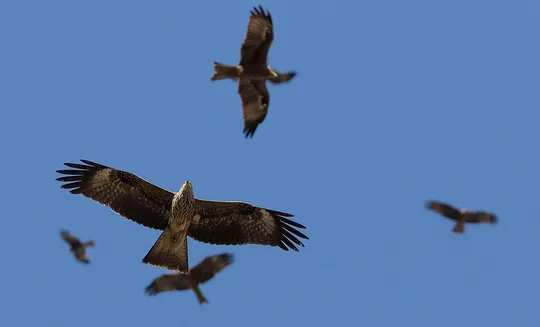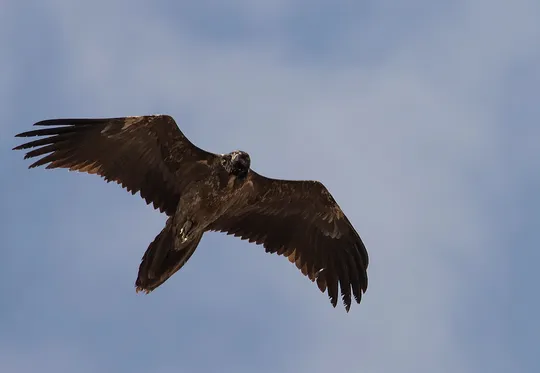Aquila pomarina
 Regionally Extinct
Regionally Extinct

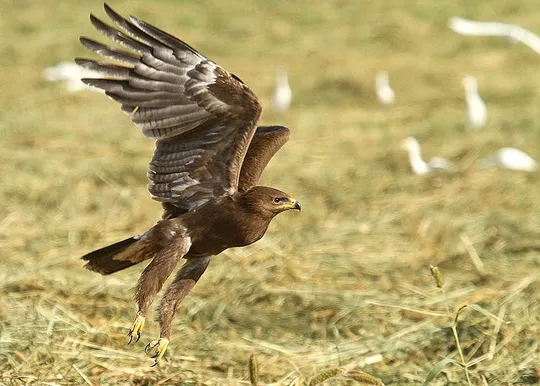
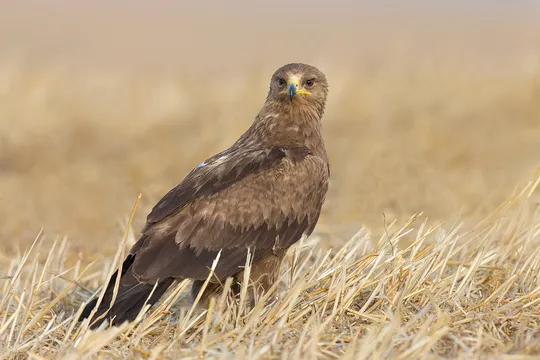
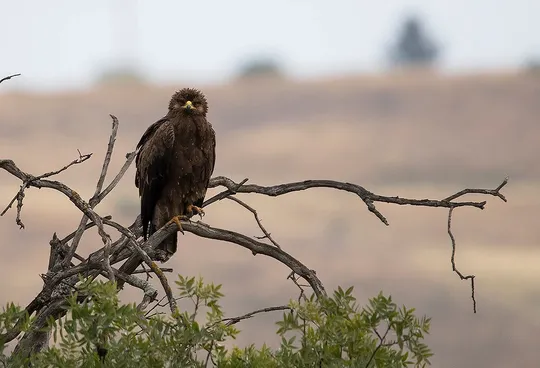
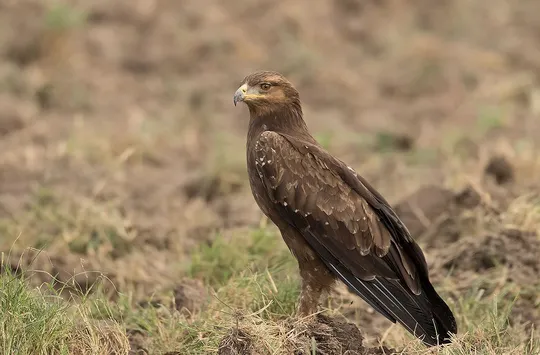
| Habitats | Parks & Woodlands, Mediterranean Maquis |
|---|---|
| Presence In Israel | Summer |
| Breeding In Israel | Bred in the past |
| Migration Types | Long Range |
| Zoographical Zones | Mediterranean |
| Landscape Types | Mountainous |
| Vegetation Types | Forest, Mediterranean Maquis, Mediterranean Garrigue, Steppe |
| Vegetation Densities | Medium |
| Nest Locations | Tree |
| Diet Types | Terrestrial Vertebrates, Carrion |
| Foraging Grounds | Ground |
| Body Sizes | Large (over 1000g) |
| Threat Factors | Pesticide Poisoning, Lead Poisoning, Hunting and trapping |
The Lesser Spotted Eagle is a relatively small and dark eagle that nests in forested areas. Its plumage is uniformly brown, its thighs or “boots” are long and narrow and its beak is small compared to other eagles. In flight, it reveals broad rectangular wings, with paler coverts than its flight and tail feathers. It feeds on small mammals that are found in open fields and plains, occasionally near water sources.
About 15 pairs of Lesser Spotted Eagles nested in northern Israel until the 1960s. Most of the nests were on the edges of the Hula Valley, but also in other parts of the Galilee, Mt. Gilboa and Mt. Carmel. An unsuccessful breeding attempt was recorded in Nahal Kziv in 1972 (Sela 1975, Paz 1986, Shirihai 1996).
About 15 pairs of Lesser Spotted Eagles formerly bred in northern Israel, particularly on the edges of the Hula Valley but also in other parts of the Galilee, Mt. Gilboa and Mt. Carmel, until the 1960s. An unsuccessful attempt at breeding was recorded in Nahal Kziv in 1972. Today Lesser Spotted Eagles are common passage migrants in most parts of Israel in autumn and spring.
The chances of Lesser Spotted Eagles returning to breed in Israel naturally are estimated to be low because of Israel’s location relative to the global range of the species (closest breeding is in southern Turkey), its extinction in Syria and Lebanon and the disjunction from Eastern European populations. All of these factors make the species low priority for reintroduction (Hatsofe & Mayrose 2015, Master Plan for Raptor Conservation in Israel ).
- הצופה, א. 2004. איזה "עיט מנוקד" קינן בישראל במאה ה- 20? העזניה 32, הוצאת טבע והדברים והחברה להגנת הטבע.
- סלע, י. 1975. סקר העופות הדורסים 1970–1975. אוניברסיטת תל-אביב: המכון לחקר שמירת הטבע.
- פז, ע. 1986. עופות. מתוך אלון, ע. (עורך), החי והצומח של ארץ ישראל. כרך 6. הוצאת משרד הביטחון, ישראל.
- Shirihai, H., 1996. The Birds of Israel. Academic Press, London.
- Symes, A. 2013. Species generation lengths. Unpublished, BirdLife International.
- Species page at Birdlife International
Distribution maps
The maps presented here provide visual information on the distribution of species in Israel from the past and present, and the changes in occupancy and breeding density during the comparison period. For further reading
Relative Abundance 2010-2020
Breeding density values in the current decade as determined from experts' opinion and observations from databases.
| Data Missing | Sporadic | Limited Sites | Low Density | High Density |
|---|---|---|---|---|
| 8 | 12 | 12 | 21 | 19 |
Relative Abundance 1980-1990
Density values based primarily on the book The Birds of Israel (Shirihai 1996).
| Data Missing | Sporadic | Limited Sites | Low Density | High Density |
|---|---|---|---|---|
| 5 | 14 | 14 | 17 | 22 |
Occupancy 1990-2020
The map shows differences in the species breeding distribution between the 1980's breeding map and the current weighted breeding evaluation. Negative value - species previously bred in the grid and is not presently breeding; positive value - species has not previously bred in the grid and is currently breeding.
| Data Missing | No Change | Occupancy Increase | Occupancy Decrease |
|---|---|---|---|
| 6 | 35 | 1 | 9 |
Change in Relative Abundance 1990-2020
The map shows the changes in the relative abundance of a species in each of the distribution grids between the breeding map of the 1980s and the weighted current breeding evaluation. Negative values - decline in abundance; positive values - increase in abundance; zero - no change in abundance.
| 80 to 100 | 50 | 20 to 30 | No Change | 30- to 20- | 50- | 100- to 80- | Data Missing |
|---|---|---|---|---|---|---|---|
| 0 | 4 | 2 | 22 | 12 | 14 | 11 | 16 |
| Rarity | |
|---|---|
| Vulnerability | |
| Attractiveness | |
| Endemism | |
| Red number | |
| Peripherality | |
| IUCN category | |
| Threat Definition according to the red book |
